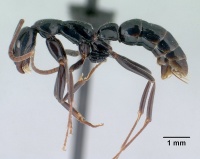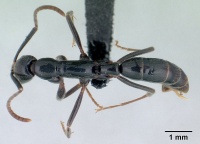Leptogenys mangabe
| Leptogenys mangabe | |
|---|---|

| |
| Scientific classification | |
| Kingdom: | Animalia |
| Phylum: | Arthropoda |
| Class: | Insecta |
| Order: | Hymenoptera |
| Family: | Formicidae |
| Subfamily: | Ponerinae |
| Tribe: | Ponerini |
| Genus: | Leptogenys |
| Species group: | attenuata |
| Species: | L. mangabe |
| Binomial name | |
| Leptogenys mangabe Rakotonirina & Fisher, 2014 | |
Foraging activity by individual workers is usually on the ground surface and rarely in leaf litter. Colonies have been recorded from rotten logs.
Identification
A member of the attenuata species group. Rakotonirina and Fisher (2014) - Worker. Third antennal segment of normal length, less than twice the length of the second; eye breaking outline of side of head; mandible smooth and shining apart from scattered piligerous punctures; in profile, lower half of propodeum from level of metathoracic spiracle and level of propodeal spiracle generally smooth; with petiole in profile, posterodorsal angle of node not projecting posteriorly nor overhanging posterior margin of node; in dorsal view, node much longer, roughly twice as long as wide.
Leptogenys mangabe can be separated from Leptogenys johary by its shorter third antennal segment, which is less than twice the length of the second segment; and from Leptogenys variabilis and Leptogenys fasika by its much longer petiolar node, which is twice as long as broad in dorsal view.
Keys including this Species
Distribution
Latitudinal Distribution Pattern
Latitudinal Range: -18.26667° to -18.26667°.
| North Temperate |
North Subtropical |
Tropical | South Subtropical |
South Temperate |
- Source: AntMaps
Distribution based on Regional Taxon Lists
Malagasy Region: Madagascar (type locality).
Distribution based on AntMaps
Distribution based on AntWeb specimens
Check data from AntWeb
Countries Occupied
| Number of countries occupied by this species based on AntWiki Regional Taxon Lists. In general, fewer countries occupied indicates a narrower range, while more countries indicates a more widespread species. |

|
Estimated Abundance
| Relative abundance based on number of AntMaps records per species (this species within the purple bar). Fewer records (to the left) indicates a less abundant/encountered species while more records (to the right) indicates more abundant/encountered species. |

|
Habitat
Ant surveys conducted on Madagascar indicate that L. mangabe has a discontinuous spatial distribution across forest habitats on the island. It has been collected from the lowland rainforests of Ambanitaza in northeastern Madagascar, the montane rainforest of the RS Ambohijanahary in the mid-west and the dry transitional forest of the PN Zombitse in the southwest of the island.
Biology
|
Castes
Worker
Images from AntWeb
   
| |
| Holotype of Leptogenys mangabe. Worker. Specimen code casent0196537. Photographer Estella Ortega, uploaded by California Academy of Sciences. | Owned by CAS, San Francisco, CA, USA. |
Male
Images from AntWeb
  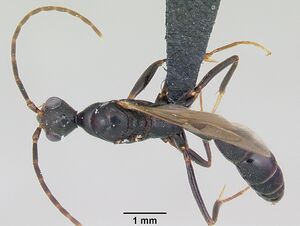 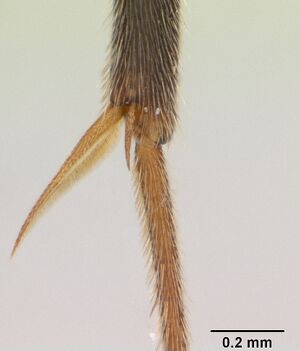 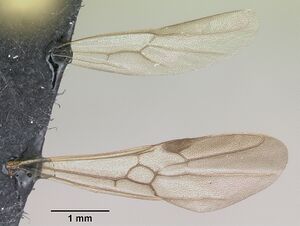  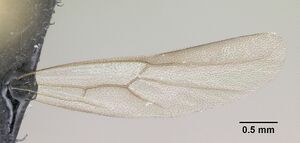 
| |
| Male (alate). Specimen code casent0496777. Photographer April Nobile, uploaded by California Academy of Sciences. | Owned by CAS, San Francisco, CA, USA. |
Nomenclature
The following information is derived from Barry Bolton's Online Catalogue of the Ants of the World.
- mangabe. Leptogenys mangabe Rakotonirina & Fisher, 2014: 57, figs. 10B, 20D, 30A, 69, 82 (w.) MADAGASCAR.
Unless otherwise noted the text for the remainder of this section is reported from the publication that includes the original description.
Description
Worker
(7 specimens). HW: 1.07–1.17, HL: 1.55–1.66, CI: 69–71, SL: 1.50–1.69, SI: 140–146, PW: 0.85–0.97, WL: 2.41–2.59, PNH: 0.65–0.73, PNL: 0.81–0.87, PNW: 0.51–0.57, DNI: 61–67, LNI: 77–90.
Head longer than broad; maximum width of head at about level of eyes; side very weakly convex posteriorly rounding to medially slightly concave posterior margin. Eye medium, maximum diameter about one-fourth the length of lateral cephalic border; in cephalic full-face view, small portion of eye extending beyond side line of head. Antennal scape long, more than one-third of its apical section surpassing posterior margin of head. Length of third antennal segment regular, less than twice the length of the second. Propodeal lobe vestigial or absent. In dorsal view, petiolar node relatively long, about twice as long as broad; anterior portion slightly compressed laterally. With petiole in profile, node inclined anteriorly, anterior margin shorter and posteriorly sloped compared to the relatively vertical posterior margin; dorsal outline broadly convex and rounding to both margins. Mandible with surface smooth and shiny, interspersed by few punctures. Body dorsum generally smooth and glossy apart from scattered piligerous small punctures. Lateral portion of mesosoma smooth and shining; declivitous surface smooth, without transverse striation. Dorsum of head and body covered with whitish-yellow erect hairs and pubescence. Body black with bluish reflection; appendages dark brown, with light brown apices; tip of gaster of much lighter color.
Type Material
Holotype worker: Madagascar, Toliara, RS Ambohijanahary, Forêt d'Ankazotsihitafototra, 35.2 km 312° NW Ambaravaranala, -18.26667, 45.40667, 1050 m, montane rainforest, ex rotten log, 13–17 Jan 2003 (Fisher, Griswold et al.) collection code: BLF07090, specimen code: CASENT0196537 (California Academy of Sciences). Paratype worker: with same data as holotype but specimen coded as: CASENT0496843 (CASC).
References
- Rakotonirina, J.C. & Fisher, B.L. 2014. Revision of the Malagasy ponerine ants of the genus Leptogenys Roger (Hymenoptera: Formicidae). Zootaxa 3836, 1-163.
References based on Global Ant Biodiversity Informatics
- Rakotonirina J. C., and B. L. Fisher. 2014. Revision of the Malagasy ponerine ants of the genus Leptogenys Roger (Hymenoptera: Formicidae). Zootaxa 3836 (1): 001163.
